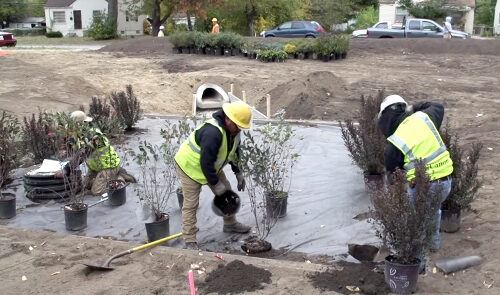
Researchers and partners work together to manage stormwater.
On the former sites of vacant Detroit homes, University of Michigan researchers and their partners have built innovative gardens that help manage stormwater while removing neighborhood blight.
The four new “bioretention gardens” are designed to capture and hold stormwater in a subsurface layer of gravel while beautifying the Cody Rouge area on Detroit’s west side. The just-completed gardens are expected to achieve an average annual stormwater volume reduction of 300,000 gallons per site, for a total of 1.2 million gallons, and should help reduce street flooding during big storms.
The pilot project shows how vacant properties can become green infrastructure that enhances neighborhood quality of life while improving water quality in the Detroit River and the Great Lakes, said project leader Joan Nassauer, a professor of landscape architecture at the U-M School of Natural Resources and Environment.
“We hope to use the lessons we learn to offer design and planning innovations that can improve the quality of life for neighborhoods in Detroit and other cities.”
– Joan Nassauer, U-M Professor of Landscape Architecture
Research for the project was funded by $285,000 from the U-M Water Center with support from the Erb Family Foundation. The gardens were constructed and instrumented for data gathering with a $500,000 investment by the Detroit Water and Sewerage Department on land owned by the Detroit Land Bank Authority. Collaborators in the project include the Cody Rouge Community Action Alliance and the Warrendale Community Organization.
The Warrendale neighborhood is part of the Cody Rouge area, which is in the Rouge River watershed. The Rouge flows into the Detroit River, which empties into western Lake Erie. Heavy rainstorms sometimes overwhelm Detroit’s wastewater treatment plant, resulting in events called combined sewer overflows, in which both stormwater and sewage are released into the lake.
Several efforts to use green infrastructure to help manage stormwater and reduce combined sewer overflows are underway in Detroit. Green infrastructure uses vegetation and soils to soak up and store stormwater slowly over 24 to 72 hours.
About $1.15 million from a new $3 million Erb Family Foundation grant to the U-M Water Center, announced in September 2015, will allow Nassauer’s interdisciplinary team to assess the performance of the Warrendale bioretention gardens over time, to monitor the acceptance and understanding of those structures by neighborhood residents, and to develop new green infrastructure design concepts tailored specifically for use in Detroit. The grant will also allow the team to distill green infrastructure knowledge from all disciplines into advice for local decision makers.

